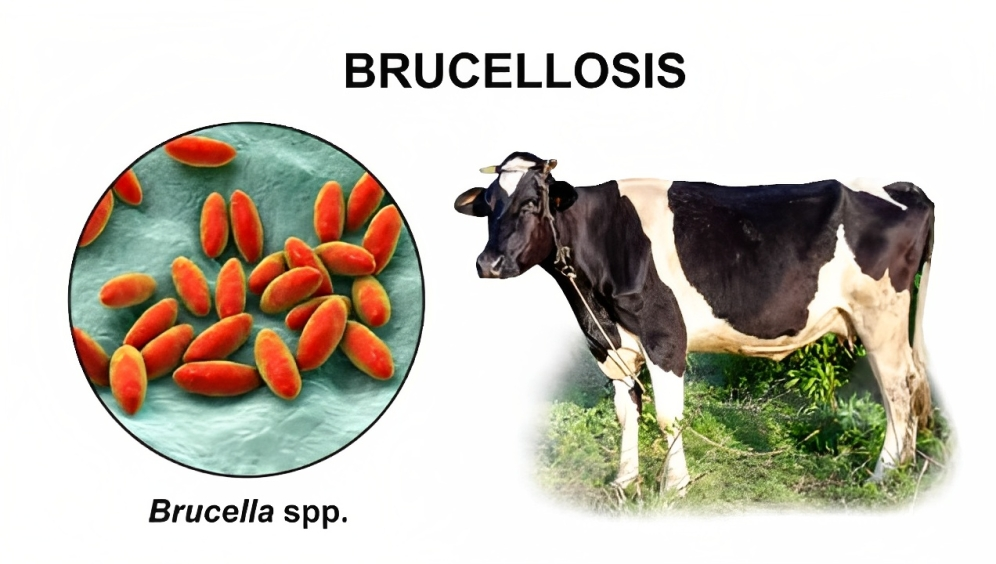Description

Copyright infringement not intended
Context: A young girl from Kerala suffered from a rare disease called Brucellosis, which is caused by bacteria that can infect animals and humans.
Details
- She first noticed swelling on her face and went to the hospital. The doctors gave her some medicine that reduced the swelling, but she soon developed a high fever and low platelet count. A urine test confirmed that she had Brucellosis.
- The source of her infection is unclear, as the cow, dog, and cat that they own did not have Brucellosis either. The only possible explanation is that she ate some dairy products from a nearby bakery that were made with unpasteurized milk.
- Experts warn that consuming raw or undercooked dairy products can increase the risk of Brucellosis and other diseases.

Brucellosis
- Brucellosis is a bacterial disease that affects various animals, such as cattle, goats, sheep, pigs, and dogs. It can also spread to humans through direct contact with infected animals or their products, such as raw milk or cheese.
- Brucellosis causes flu-like symptoms, such as fever, weakness, malaise, and weight loss. It can also lead to chronic complications, such as arthritis, endocarditis, and spondylitis.
- It is one of the most widespread zoonoses in the world and has serious public health consequences.
- The prevention and control of brucellosis depend on the elimination of infection in animals through vaccination or culling, the pasteurization of milk and dairy products, the education of consumers and workers about the risks and preventive measures, and the surveillance and reporting of cases.
Humans can get infected with brucellosis by:
- Eating or drinking contaminated animal products, especially unpasteurized milk or cheese from goats or sheep.
- Inhaling airborne bacteria from animal secretions or carcasses.
- Touching blood, placenta, semen, or uterine fluids of infected animals through cuts or wounds.
- Person-to-person transmission is very rare.
Symptoms
- Fever
- Chills
- Loss of appetite
- Sweats
- Weakness
- Fatigue
- Joint, muscle, and back pain
- Headache
The symptoms may disappear for weeks or months and then return. Some people may have chronic brucellosis and experience symptoms for years, even after treatment.
Treatment and Prevention
- Brucellosis can be treated with antibiotics, but the treatment may take several weeks to months and the infection may recur.
- The best way to prevent brucellosis is to avoid contact with infected animals and their products.
- Some preventive measures are:
- Pasteurizing milk and dairy products before consumption.
- Cooking meat thoroughly before eating.
- Wearing protective gloves, masks, and clothing when handling animals or working in laboratories.
- Disposing of animal waste properly.
- Vaccinating animals in areas where brucellosis is endemic.

Conclusion
- Brucellosis is a zoonosis caused by ingestion of unpasteurized milk from infected animals or close contact with their secretions. It can cause flu-like symptoms, such as fever, chills, loss of appetite, sweats, weakness, fatigue, joint, muscle and back pain and headache. The infection can be treated with antibiotics, but it may take several weeks to months and it may recur. It can be prevented by avoiding raw dairy products, taking precautions when working with animals or in a laboratory, and vaccinating animals in endemic areas.
Must-Read Articles:
Livestock and Zoonosis: https://www.iasgyan.in/daily-current-affairs/livestock-and-zoonosis
ZOONOSIS THEORY: https://www.iasgyan.in/daily-current-affairs/zoonosis-theory#:~:text=A%20zoonosis%20is%20an%20infectious,a%20human%20and%20vice%20versa.
|
PRACTICE QUESTION
Q. The most common way that humans acquire brucellosis is by:
1. Eating raw or unpasteurized dairy products
2. Inhaling contaminated air
3. Touching blood and body fluids of infected animals
Choose the correct code;
A) 1 and 2 only
B) 2 and 3 only
C) 1 and 3 only
D) 1, 2 and 3
Answer: D
Explanation: All of these are possible routes of transmission for brucellosis, but eating raw or unpasteurized dairy products is the most common one.
|
https://keralakaumudi.com/en/news/news.php?id=1105582&u=7-year-old-kollam-girl-affected-by-rare-brucellosis-shifted-to-sit-hospital







